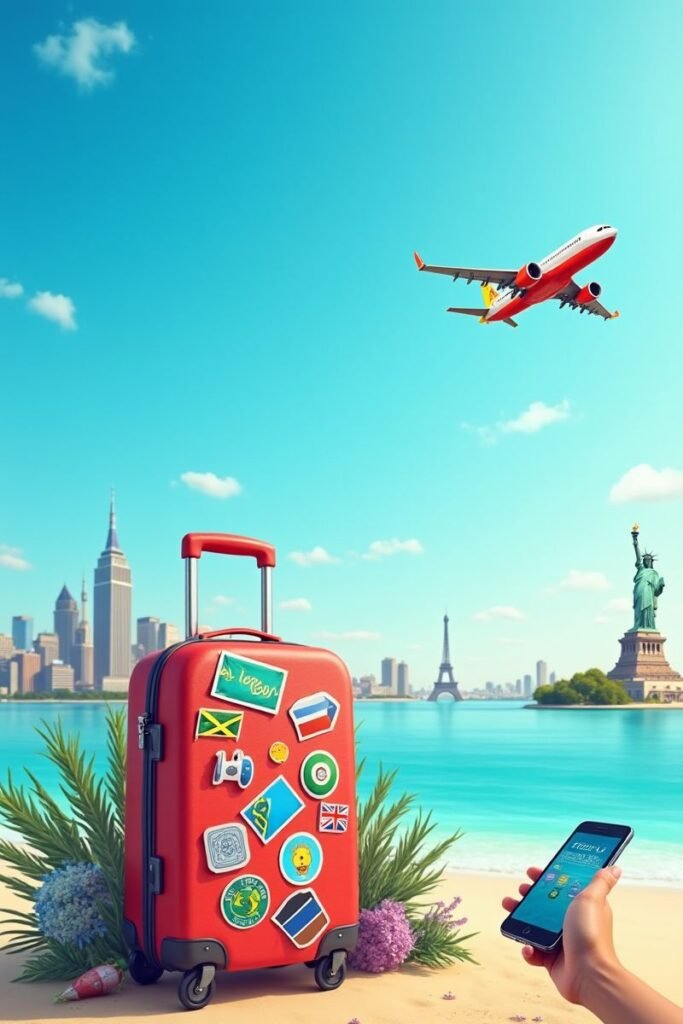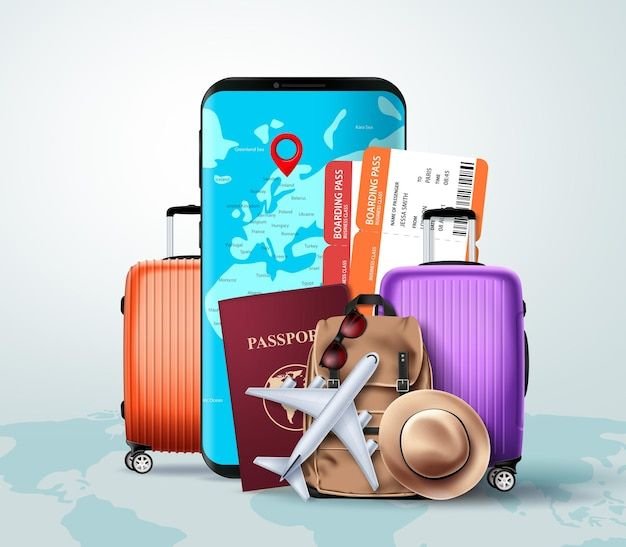1. Introduction
Travel Tips has become an integral part of modern life. Whether it’s commuting to work, running errands, attending meetings, or enjoying short weekend getaways, most people spend a significant portion of their day on the move. While travel can be exciting and liberating, it often comes with challenges—traffic jams, crowded public transport, lost items, long queues, and unexpected delays can turn a simple journey into a stressful experience.
Fortunately, incorporating small, practical Travel Tips into your daily routine can transform the way you move from one place to another. These hacks are not about expensive gadgets or luxury travel; they are simple, actionable strategies that save time, reduce stress, and make every journey more enjoyable. By learning to plan efficiently, pack wisely, leverage technology, and maintain a positive mindset, anyone can turn their daily Travel Tips experiences into smoother, more productive, and even enjoyable moments.
Everyday Travel Tips are especially valuable in today’s fast-paced world. Many people juggle multiple responsibilities, from professional commitments to personal errands, and even short delays or inconveniences can disrupt the entire day. By applying effective strategies, you can prevent minor obstacles from escalating into major frustrations. For instance, planning your route in advance can save you from unnecessary detours, while packing smart ensures that you carry only what’s essential, reducing the burden on your shoulders. Similarly, using technology, such as navigation apps, mobile tickets, or travel reminders, allows you to stay ahead of potential disruptions and stay informed in real time.
This article explores 10 practical everyday Travel Tips that anyone can implement. These tips cover everything from route planning and packing to staying comfortable, safe, and entertained while on the move. Whether you are a daily commuter, a frequent traveler, or someone who enjoys short trips around your city, these strategies will help you travel more efficiently, reduce stress, and make every journey a positive experience. By adopting these hacks, you not only save time and energy but also improve your overall Travel Tips experience, turning routine commutes and short trips into more enjoyable and productive parts of your day.

2. Hack 1: Plan Your Route in Advance
One of the simplest yet most effective ways to make your daily journeys stress-free is planning your route before you start traveling. Whether you’re commuting to work, heading to a meeting, or going on a weekend trip, knowing the best route in advance can save you time, reduce frustration, and help you avoid unexpected obstacles.
2.1 Use Navigation Apps
Modern technology makes route planning easier than ever. Apps like Google Maps, Waze, Citymapper, and Apple Maps provide real-time traffic updates, estimated Travel Tips times, and alternate routes. These apps allow you to:
- Identify the fastest or shortest routes based on current traffic conditions.
- Avoid construction zones, road closures, and heavy traffic areas.
- Plan routes using different modes of transport, such as driving, walking, cycling, or public transit.
By checking your route before leaving home, you can anticipate delays and adjust your schedule accordingly. For instance, leaving 10 minutes earlier to avoid peak-hour congestion can make your commute smoother and less stressful.
2.2 Plan for Public Transport
For those who rely on buses, trains, or metro systems, advanced planning is equally important:
- Check timetables and service alerts to avoid cancellations or delays.
- Use transit apps to track live arrival times and seat availability when possible.
- Plan connections carefully to minimize waiting times and missed transfers.
This approach ensures that you’re not caught off guard by sudden changes in public transport schedules and helps you optimize your travel time.
2.3 Have Backup Routes
Unexpected situations like accidents, roadblocks, or sudden weather changes can disrupt even the best-planned trips. Having alternate routes in mind ensures you can adapt quickly without wasting time. Keep a primary route, a secondary route, and, if possible, a public transport alternative ready. Apps like Waze or Google Maps allow you to save multiple routes for quick access.
2.4 Benefits of Advanced Planning
Planning your route in advance provides multiple advantages:
- Saves Time: Avoid unnecessary detours or traffic jams.
- Reduces Stress: Minimizes uncertainty and last-minute decisions.
- Enhances Productivity: Allows you to use Travel Tips time more effectively, such as catching up on calls, reading, or listening to podcasts.
- Increases Safety: Avoids risky maneuvers in traffic or unfamiliar areas.
By making route planning a daily habit, you can transform your commuting or Travel Tips experience into a smoother, more predictable part of your routine. It’s a small step that yields significant benefits, especially when combined with other travel hacks in this guide.
3. Hack 2: Pack Smart and Light
Packing efficiently is a key factor in stress-free travel. Many travelers, especially those commuting daily or going on short trips, make the mistake of carrying too much or forgetting essential items. Packing smart and light saves time, reduces physical strain, and ensures you have everything you need without unnecessary clutter.
3.1 Focus on Essentials
Before you start packing, consider the purpose and duration of your travel. Ask yourself:
- What items do I absolutely need for today or this trip?
- Are there items I can leave at home or in the office?
For daily commutes, essentials might include:
- Wallet, keys, and phone
- Work documents or laptop/tablet
- Snacks and a water bottle
- A light jacket or umbrella depending on weather
For weekend getaways or short trips, pack only what you will realistically use. Avoid the temptation to overpack “just in case” items, as they often remain unused and add unnecessary weight.
3.2 Use Packing Cubes and Organizers
Packing cubes and small organizers help categorize your items, making them easy to locate. Benefits include:
- Keeping electronics, chargers, and cables organized.
- Separating clothing by type or outfit, reducing the need to dig through the bag.
- Maximizing space in backpacks or carry-on luggage by compressing items efficiently.
For everyday travel, a small organizer for personal items such as pens, notebooks, or makeup ensures you can quickly find what you need without rummaging through your bag.
3.3 Roll Your Clothes
Rolling clothes instead of folding them is a simple hack that saves space and prevents wrinkles. This method works especially well for lightweight fabrics such as t-shirts, casual pants, and scarves. Pair rolling with packing cubes to further organize your items and streamline your bag.
3.4 Multi-Functional Items
Choose items that serve more than one purpose. For example:
- A scarf that can double as a blanket or pillow on long commutes.
- Shoes that are comfortable for walking but stylish enough for meetings or social outings.
- Jackets with multiple pockets to carry essentials without adding an extra bag.
3.5 Benefits of Smart Packing
Packing light and efficiently offers multiple advantages:
- Reduces Stress: Less weight means easier handling and fewer forgotten items.
- Saves Time: Quick access to essentials prevents delays when moving through stations, airports, or offices.
- Enhances Mobility: Smaller bags allow you to navigate crowded streets, trains, or buses effortlessly.
- Prevents Overpacking Costs: For flights, lighter luggage can avoid excess baggage fees.
By making smart packing a habit, your daily and short-term travels become more streamlined and enjoyable. You’ll spend less time worrying about what to bring and more time focusing on the journey itself.

4. Hack 3: Use Technology for Travel Efficiency
In today’s fast-paced world, technology plays a vital role in simplifying travel. From planning your journey to purchasing tickets and tracking transportation, digital tools can save time, reduce stress, and make Travel Tips more enjoyable. Incorporating the right apps and devices into your daily routine ensures you’re always prepared for unexpected delays or changes.
4.1 Navigation and Traffic Apps
Navigation apps are essential for both drivers and public transport users. Tools like Google Maps, Waze, Apple Maps, and Citymapper provide real-time traffic updates, route optimization, and estimated Travel Tips times:
- Drivers can avoid congested areas, construction zones, and accidents.
- Public transport users can track bus and train schedules, check live arrival times, and even find alternative routes if delays occur.
- Some apps offer offline maps, allowing navigation even in areas with poor connectivity.
By checking your route before leaving and during your journey, you can stay ahead of potential obstacles and save valuable time.
4.2 Mobile Tickets and Digital Passes
Carrying physical tickets can be cumbersome and easy to lose. Most transit systems, airlines, and event organizers now support mobile tickets and digital passes:
- Airlines allow boarding passes to be stored on phones.
- Train and bus services offer QR codes or NFC-enabled passes for quick access.
- Some cities provide digital passes for ridesharing, bike rentals, or metro systems.
Using digital tickets not only reduces clutter but also speeds up entry, reducing wait times and stress.
4.3 Travel Planning Apps
Apps dedicated to Travel Tips planning, such as TripIt, Kayak, and Hopper, help organize itineraries in one place:
- Consolidate flight, hotel, and transport information.
- Receive real-time updates about delays or cancellations.
- Set reminders for departure times, check-ins, and reservations.
By keeping all travel-related information in a single app, you eliminate confusion and avoid missing important connections.
4.4 Time Management and Reminder Apps
Efficient Travel Tips also involves managing your time effectively. Apps like Google Calendar, Todoist, or Any.do allow you to:
- Schedule Travel Tips and buffer times for unexpected delays.
- Receive notifications for departure times, appointments, or meetings.
- Coordinate multi-stop journeys efficiently, combining errands or appointments in the shortest time.
These tools help ensure that Travel Tips integrates seamlessly into your daily routine.
4.5 Benefits of Using Technology for Travel
Incorporating technology into your Travel Tips habits provides several advantages:
- Saves Time: Quickly find optimal routes, alternative paths, and updates on transport delays.
- Reduces Stress: Eliminates uncertainty and last-minute confusion.
- Improves Organization: Consolidates Travel Tips schedules, tickets, and reminders in one place.
- Enhances Safety: Allows tracking of Travel Tips routes, estimated arrival times, and emergency alerts.
By embracing the right technology, you can transform daily Travel Tips from a chaotic routine into a smooth, well-organized experience. Using apps for navigation, planning, and time management ensures that you stay in control of your journey, no matter how busy or complex your travel schedule may be.
5. Hack 4: Carry a Portable Charger and Essentials
A common source of Travel Tips frustration is running out of power or forgetting crucial items. Whether you’re commuting daily, traveling for work, or exploring a new city, having a portable charger and essential items on hand can make a significant difference in your Travel Tips experience.
5.1 The Importance of a Portable Charger
Smartphones, tablets, and other electronic devices are vital for navigation, communication, ticketing, and entertainment during travel. Running out of battery at a critical moment can disrupt your plans and cause unnecessary stress. A high-capacity portable charger (power bank) ensures:
- Continuous access to maps, transit apps, and digital tickets.
- Ability to stay connected via calls or messaging apps.
- Backup power for emergencies, like contacting authorities or Travel Tips assistance.
When choosing a power bank, consider factors like battery capacity, portability, and the number of devices it can charge simultaneously. Lightweight, compact chargers are ideal for daily commutes, while larger capacity ones may suit longer trips.
5.2 Essential Travel Items to Carry Daily
Beyond power, certain items enhance convenience and preparedness:
- Water Bottle: Staying hydrated keeps you alert and comfortable, especially during long commutes or Travel Tips in hot weather.
- Snacks: Healthy snacks like nuts, protein bars, or fruits prevent energy dips and reduce hunger-related stress.
- First Aid Items: Band-aids, antiseptic wipes, and basic medications help address minor injuries or discomfort quickly.
- Umbrella or Raincoat: Protects against sudden weather changes, keeping you dry and comfortable.
- Headphones or Earplugs: Useful for noisy commutes or enjoying audio entertainment.
- Reusable Bag or Tote: Helps carry additional purchases or items collected during the day.
Having these essentials readily accessible reduces the chances of last-minute scrambling and keeps your journey smooth and stress-free.
5.3 Organizing Your Essentials
Keeping your items organized ensures quick access:
- Use small pouches or compartments in your backpack for electronics, chargers, and cables.
- Separate food and drinks to prevent spills.
- Keep frequently used items, like tickets or ID cards, in easily accessible pockets.
5.4 Benefits of Carrying a Charger and Essentials
- Reduces Stress: You won’t worry about dead batteries or missing essential items.
- Increases Productivity: Staying powered up allows you to work, navigate, or communicate efficiently while traveling.
- Enhances Comfort: Ready access to snacks, water, and weather protection keeps your journey pleasant.
- Prepares You for Emergencies: First aid items and backup power provide peace of mind in unexpected situations.
By making a habit of carrying a portable charger and a small set of essential items, you can handle most daily Travel Tips challenges effortlessly. This simple preparation ensures that whether you’re commuting, running errands, or on a short trip, your journey remains smooth, efficient, and enjoyable.
6. Hack 5: Optimize Travel Times
Travel Tips isn’t just about the route you take—it’s also about when you travel. Choosing the right Travel Tips times can significantly reduce stress, save time, and improve your overall experience, whether you’re commuting to work, running errands, or heading out on a short trip.
6.1 Avoid Peak Hours
One of the easiest ways to optimize Travel Tips time is to avoid peak traffic or crowded public transport hours:
- For city commuters, traveling outside rush hours (typically 7–9 AM and 5–7 PM) can cut down Travel Tips time by a significant margin.
- Off-peak Travel Tips reduces the stress of crowded buses, trains, and roads.
- If your schedule is flexible, consider shifting meetings or appointments to avoid high-traffic periods.
Even a 30–60 minute adjustment in departure time can make a noticeable difference in comfort and efficiency.
6.2 Combine Errands Efficiently
Optimizing Travel Tips also involves planning multiple stops logically:
- Group errands by location to minimize backtracking.
- Use route-planning apps to identify the most efficient sequence of stops.
- Plan grocery shopping, appointments, and other errands in a single outing rather than multiple trips.
This approach saves both Travel Tips time and energy, making daily routines more manageable.
6.3 Early Departures for Longer Trips
For longer trips or weekend getaways:
- Depart early in the morning to avoid both traffic and fatigue.
- Early departures often lead to lighter roads and quicker travel times.
- Morning travel also increases the likelihood of finding parking spots and reduces stress at ticket counters or check-ins.
6.4 Consider Weather and Seasonal Factors
Timing your Travel Tips around weather conditions can prevent delays:
- Avoid traveling during rush-hour rainstorms or extreme weather events.
- Check weather apps for predictions and plan accordingly.
- For seasonal trips, consider traffic patterns around holidays, festivals, or school vacations.
6.5 Benefits of Optimizing Travel Times
- Saves Time: Strategic planning reduces hours wasted in traffic or queues.
- Reduces Stress: Fewer delays and less crowded conditions improve your mental state.
- Increases Efficiency: Combines multiple tasks or errands in a single, well-planned journey.
- Enhances Comfort: Less congestion and better weather conditions make travel enjoyable.
By paying attention to when you travel, not just how, you can turn stressful journeys into smoother, more predictable experiences. Incorporating this hack into your daily routine ensures that each trip, whether short or long, is as efficient and comfortable as possible.

7. Hack 6: Stay Comfortable During Travel
Comfort is a key factor in making travel enjoyable. Long commutes, crowded public transport, and extended journeys can quickly become exhausting if you’re not dressed appropriately or prepared with the right accessories. Staying comfortable ensures that you arrive at your destination feeling relaxed, refreshed, and ready to tackle your day.
7.1 Choose Comfortable Clothing
Selecting the right attire for Travel Tips can make a world of difference:
- Layering is Key: Wear layers that can be added or removed depending on temperature changes in buses, trains, or office buildings.
- Breathable Fabrics: Cotton, linen, or moisture-wicking materials help regulate body temperature and prevent discomfort.
- Stretch-Friendly Options: Clothing with a bit of stretch allows for easier movement during long walks or crowded transport.
For business trips or commuting to work, you can balance style and comfort by choosing professional-looking but flexible clothing.
7.2 Footwear Matters
Shoes have a major impact on travel comfort:
- Comfortable walking shoes or sneakers are ideal for long commutes or sightseeing.
- Avoid brand-new shoes that may cause blisters or discomfort.
- If style is a concern, consider versatile footwear that looks professional but feels comfortable for extended walking.
7.3 Accessories for Comfort
Certain travel accessories enhance comfort and convenience:
- Travel Pillow or Neck Support: Useful for longer trips on trains, buses, or flights.
- Sunglasses and Hat: Protects against sun glare and keeps you comfortable outdoors.
- Reusable Water Bottle: Staying hydrated prevents fatigue and discomfort.
- Backpack or Sling Bag: Distributes weight evenly and reduces strain on your shoulders.
7.4 Maintain Posture and Ergonomics
Good posture is essential for long journeys:
- Sit upright with your back supported and avoid slouching.
- Keep feet flat on the ground to reduce strain on your legs and back.
- If standing, shift weight occasionally and maintain balance to prevent fatigue.
7.5 Benefits of Staying Comfortable
- Reduces Fatigue: Comfortable clothing and proper posture prevent unnecessary exhaustion.
- Improves Mood: Feeling physically at ease positively affects your mental state.
- Enhances Productivity: Comfortable travelers can read, work, or plan efficiently during their journey.
- Prevents Health Issues: Proper footwear and posture reduce risks of back pain, foot strain, and other travel-related discomforts.
By prioritizing comfort in your Travel Tips routine, you can make daily commutes and longer journeys more enjoyable. Small choices in clothing, accessories, and posture contribute significantly to a smoother, stress-free travel experience.
Related Post: 7 Proven Fixes for Smartwatch Not Receiving Calls or Messages

